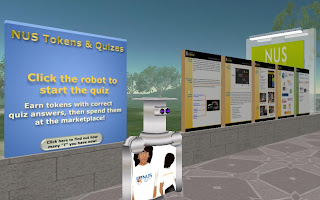Just read the
news on Virtually Blind about the court case between Blizzard and the botters, i.e. WoWGliders. What is most interesting is the enclosed
Castronova's expert report on botters.
Firstly I must say that I dislike botters, and secondly, I like and I play World of Warcraft (without use of any bot programs!).
However, there are many parts of Castronova's arguments that I disagree with. He argues that there is unfairness felt by players when other players use the bots. Unfairness stemmed from two perspectives, i.e. that the botters level much faster which makes others feel inferior, and the botters can farm for gold and items that cause inflation to the in-world economy. This unfairness then cause damages for Blizzard. The actual arguments are longer and worth a read.
Sure, the botters can level faster and farm much more effectively compared to real players. However, this does not in itself necessarily cause unhappiness among players.
WoW is not a game with an end goal such that the first player who reaches level 70 wins and everyone else loses. People play WoW cos' of the immersive environment (mentioned in his arguments) which includes graphics, design of quests, music...etc etc. So what if there are many botters who reached level 70? The people simply missed out the fun of the journey, i.e. the quests and quest rewards along the way. There are many other games who provide the legitimate options of letting players having 2x experience or 2x gold, e.g.
MapleStory, in recognition of such a demand from players with limited game time.
Level 70 onwards for WoW is a different game-play where the focus is on raids, and bots can't participate in raids. Let me know if you are aware of bots in raids, the details would be interesting.
Thus the only issue is about the grinding in-between level 1 and level 70. Quests helps, and Blizzard can definitely do more to cut down the grinding time. Have more interactive quests that give good experience points, rather than those 'get 10 stone slabs' types of quests that do nothing but require players to grind! Reduce the disincentive of grinding, and players will not have the need to pay separately for bot programs. It is the grinding portion, that makes players feel unhappy when they see the botters in the game. It's a case of "I'm suffering from the grind, why aren't you?". But why the need to suffer in the first instance? Personally I find the grinding from level 40 to 50ish especially tedious.
I think Blizzard knows that, thus the reward experience and items for Burning Crusade reflect it (I think). Quests in Burning Crusade gives much better items compared to general mob drops. Generally bots don't do quests, and so would miss out on the items. So I guess they are already fixing that in the game.
The second portion of in-game inflation is also something I disagree with. So bots cause inflation? Lolz, step into the Auction House (AH) and take a look. When bots are around, the prices deflate! This is a case of supply and demand. When there is a huge supply of goods from bots, the prices of these goods fall in the AH, especially for those craft related items like gems. Picture of a AH below. For non-WoW readers, AH is an auction mechanism that allows trade among players.

Sure, gold buyers can have access to a lot of gold from the botters using real cash. Then gold buyers use their large supply of gold to buy items / enchantments...etc. Isn't this good for the actual players, i.e. those normal players who then have a ready supply of clients for enchantments, jewel-making ... etc etc? Worried about gold buyers' demand that cause a price increase for armours, weapons...etc? Just make the better items 'bind on pick-up', i.e. can't sell these items in AH. Gold buyers would be stupid to pay lot of gold for a more inferior item. For non-WoW readers, here's a pic of what you see when you click on the auctioneer in AH.
So, it's a matter of incentive again much like the 'grinding' case above. Reduce the incentive for gold buyers, i.e. give better items for quests which gold cannot buy, and the demand for these quick gold would drop.
I think Blizzard is smart enough to understand these since the dynamics for Burning Crusade, i.e. items drops versus quests or 'bind on pick-up' are different from pre Burning Crusade game-play. Blizzard can sue the bot software developers whatever ways it wants, but let's have even better game dynamics for the next game expansion ok?
 IDC organised a free seminar today (24th June) on Web 2.0 Digital marketplace, with Yahoo! as the big sponsor. The seminar was over-subscribed substantially, such that the hotel staff needed to pull in a large number of chairs from the next seminar room. The fourth speaker actually remarked that there is a large increase in Singapore in the interest in Web 2.0 applications and services, especially for the enterprise community.
IDC organised a free seminar today (24th June) on Web 2.0 Digital marketplace, with Yahoo! as the big sponsor. The seminar was over-subscribed substantially, such that the hotel staff needed to pull in a large number of chairs from the next seminar room. The fourth speaker actually remarked that there is a large increase in Singapore in the interest in Web 2.0 applications and services, especially for the enterprise community.


























































